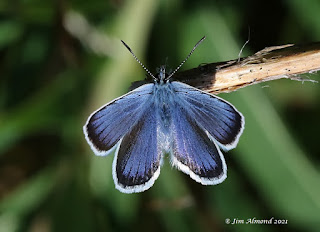Visitors to my blog will have noticed that many of my recent posts feature insects rather than birds. Like many other birders, I’ve developed a passion for selected insect families and am now broadening my horizons even further, seeing new insects, virtually every time I’m in the field. Whatever your level of interest, a good field guide is essential. This will help to expand your knowledge and steer you to a successful and accurate identification of the ‘unknown’ species you are agonising over!
If you are in the market for a book that gives you the ability to identify insect species purely from visual observation or photographs in the field, I have some great news, a new title in the ‘Wildguides’ series entitled ‘Britain's Insects’, is now available!

Written by well-known expert and prolific author Paul D Brock, the Wildguides ‘mission’ of ensuring up to date content plus the best images from top photographers has combined to produce a masterpiece field guide ‘tome’. It is probably at the limit for a single softback volume too, weighing in at around 1.5kg, packed with 1653 insect species amongst the 608 pages. The photographs are larger than previous photo-guides on the subject and clearly chosen at angles to best demonstrate the key identification features of the species concerned. A simplified description of the insect orders will help to narrow down which family an unknown insect belongs to by referring to common representatives. A little time spent here may save the beginner from simply leafing aimlessly through the whole book!

A glossary of technical terms is included which concentrates on those in frequent general use. Terms which are specific to a particular order are included in an annotated image at the beginning of a particular section. A brief section of watching and photographing insects together with some snippets of their behaviour takes the reader up to the species accounts. The text caters admirably for the beginner, using English names for every insect included plus the scientific name for each order, family, genus and species. The standard template of information for each species (page 33) is worth digesting before you read on, there is so much important coded information here. For each insect, measurements and key identification features are noted plus similar species (where relevant) to help the beginner avoid pitfalls. The likely habitat and specific foodplants will help you look in the right places plus a distribution map details where records currently exist. The phenology chart should help the user to search for a particular insect at the correct time.

The accounts vary in their coverage of the orders, including every species in some orders eg Odonata (Dragonflies and Damselflies) 27 pages, Orthoptera (Crickets and Grasshoppers) 30 pages and Lepidoptera (Butterflies but not all Moths) 83 pages. These are obviously some of the most showy and popular of our insects and likely to enthuse interest in other orders through chance encounters whilst in the field. A useful list of further reading where appropriate accompanies the first page of each order. One of the two additional more specialised field guides mentioned will become essential reading to recognise some of the vast array of female / immature patterns which may bewilder the novice but become a prime focus for the keen observer.

The Orthoptera section features a QR code for most of the UK Crickets and Grasshoppers. This code links to a sound recording of the species of interest, an app will be needed on your phone to read this. Close up images of the pronotum shape and structure help ease the observer into Grasshopper identification, all species are annotated with the key identification features.
Many families are prefaced with a table containing a descriptive identification key (example below). These will help give an understanding of the aspects and angles needed for photography to enable an identification to species level rather than identifying as simply or Mason Wasp’ for example.
The final 30 pages are devoted to conservation status and legislation, further reading and useful websites / online resources and insect societies. The index allows for searches using either common or scientific name and is well laid out. The rear cover flap features a useful alphabetical index to Orders as well, following the same nomenclature.
Published by Princeton University Press on 8th June 2021, the target price of £25.00 can currently be found as low as £18.31 at selected outlets online.
This is my second ‘Insect’ field guide written by Paul Brook and in case anyone is hesitating to add another book to their collection, I have to say they complement each other rather well! Apart from simply helping to identify insects, there is so much background information in the species accounts and elsewhere, it makes for good reading. The clear images are exemplary and unmatched at present. It is a ‘must have’ for everyone with a general interest in insects and I’m sure it will sneak into the libraries of quite a few seasoned experts too!
























































